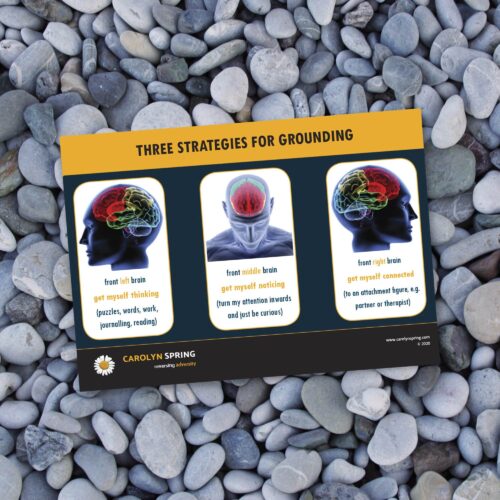This poster PDF provides three strategies for grounding based on three parts of the ‘front brain’ – cognitive strategies using the front left brain, reflective strategies using the front middle brain, and relational strategies using the front right brain.
It’s a quick-and-easy reminder of different things we can try when triggered and complements my article ‘Managing Triggers‘.
This is a free downloadable PDF.
Page 1 is a full-colour poster.
Page 2 is a low-ink, print-friendly version.
When we are triggered, we are often encouraged to ‘ground’. But what does this actually mean?
In essence, we are talking about moving from a state dominated by our back brain (which dominates in danger mode, when we perceive threat) back into our front brain (which is effective in daily life mode, when we feel safe.)
Our front brain is our clever, thinking, rational, neo-cortex, where we can assess reality and make conscious decisions based on choices – not on instinctive, danger-based, survival-driven reactions. Being grounded means that our front brain has come back online.
The front brain can be divided (more metaphorically than precisely neuroscientifically!) into three ‘parts’:
- the front left brain (the dorsolateral prefrontal cortex) is the facts and words part of our brain. We can bring it online with word-puzzles, journalling, talking and focusing on what we know cognitively. (The front left brain is often the focus of CBT.)
- the front middle brain (the medial prefrontal cortex) is the part of the brain with which we can be self-reflective, where we can look inside and ‘just notice’ and ‘just be curious’ about what is happening in our body, and observe our thoughts and feelings. It comes online when we turn our attention to our inner sensations, for example with mindfulness and meditation. (The front middle brain is often the focus of Sensorimotor Psychotherapy and approaches such as mindfulness-based stress reduction.)
- the front right brain (the right orbitofrontal cortex) is the attachment and relational part of the brain with which we connect with others. We can bring it online by reaching out to people, especially an attachment figure, who can help to regulate our nervous system by this soothing presence. (The front right brain is often the focus of attachment-based therapies, as well as in general terms person-centered approaches).
So when triggered, it can be helpful to think in terms of these three parts of the brain and then three strategies – what is available to me right now?
- Can I journal or distract with reading or in some way engage my working brain?
- Can I breathe and focus myself through mindfulness-based strategies?
- Or can I reach out for co-regulatory support from someone else?
For more information, check out my article ‘Managing Triggers‘ or my training ‘Dissociation and DID: The Fundamentals‘.
